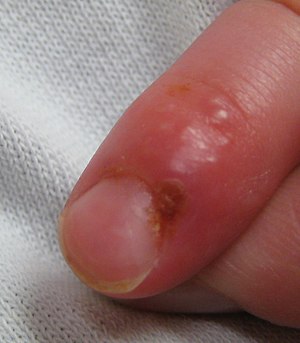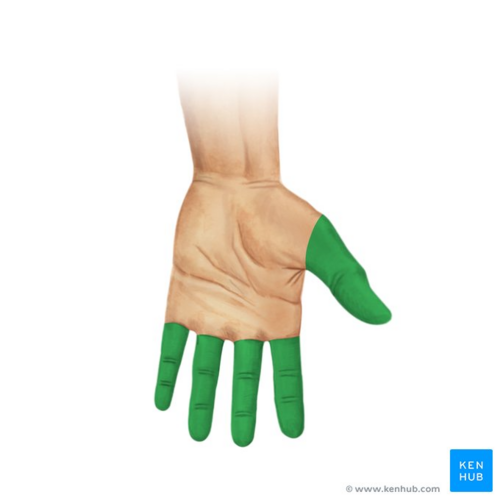Whitlow: Difference between revisions
Joao Costa (talk | contribs) No edit summary |
m (added text, corrected tenses) |
||
| Line 5: | Line 5: | ||
== Introduction == | == Introduction == | ||
[[File:Whitlow.jpg|thumb]] | [[File:Whitlow.jpg|thumb]] | ||
Whitlow is a very painful and infectious viral disease of the thumb and fingertips. Rarely, it infects the toes and nail cuticle. <ref>Clark DC. Common acute hand infections. American Family Physician. 2003;68 (11):2167–76.</ref> It is a self-limiting disease and it is of two types - Herpetic Whitlow and Melanotic Whitlow. Herpetic whitlow is more prevalent of the two. It is a disease of the [[Wrist and Hand|hand]] | Whitlow is a very painful and infectious viral disease of the thumb and fingertips. Rarely, it infects the toes and nail cuticle. <ref>Clark DC. Common acute hand infections. American Family Physician. 2003;68 (11):2167–76.</ref> It is a self-limiting disease and it is of two types - Herpetic Whitlow and Melanotic Whitlow. Herpetic whitlow is more prevalent of the two. It is known as a disease of the [[Wrist and Hand|hand]] | ||
== Mechanism of Injury / Pathological Process == | == Mechanism of Injury / Pathological Process == | ||
Herpetic whitlow is caused by the Herpetic Simplex Virus (HSV). HSV is of two types - type 1 and type 2. <ref>Wu IB, Schwartz RA. Herpetic Whitlow. Cutis. 2007;79(3): 193–6.</ref> They are both known to cause whitlow. Herpetic whitlow is caused when | Herpetic whitlow is caused by the Herpetic Simplex Virus (HSV). HSV is of two types - type 1 and type 2. <ref>Wu IB, Schwartz RA. Herpetic Whitlow. Cutis. 2007;79(3): 193–6.</ref> They are both known to cause whitlow. Herpetic whitlow is caused when wounded and exposed skin comes in contact with body fluids contaminated with HSV. It may also be caused by bacterial fingertip infection. <ref>Hoff NP, Gerber PA. "Herpetic whitlow". Canadian Medical Association Jouurnal. 2012;184: E924</ref> | ||
Risk factors include; | Risk factors include; | ||
* Human Immunodeficiency Virus (HIV) infection | * Human Immunodeficiency Virus (HIV) infection | ||
* Nail biting habit | * Nail biting habit | ||
* Wounded finger with exposed skin surface | * Wounded finger with the exposed skin surface | ||
* | * A career in the healthcare profession | ||
== Clinical Presentation == | == Clinical Presentation == | ||
| Line 36: | Line 36: | ||
== Management / Interventions == | == Management / Interventions == | ||
Although, there is no known cure | Although, there is no known cure for the disease and the disease is a self-limiting one, therefore, it usually resolves within two to three weeks. However, certain measures may be undertaken to improve the symptoms. These include; <ref name=":0" /><ref>Ismailov TA, Yevdulov OV, Khazamova MA, Gidurimova DA. Experimental Investigations of Thermoelectric Device for the Therapy of Whitlow. Journal of Thermoelectricity. 2013;4:78-84</ref> | ||
* Topical | * Topical analgesic to reduce pain and itching | ||
* Antiviral medications | * Antiviral medications | ||
* Analgesics to reduce pain and fever (if present) | * Analgesics to reduce pain and fever (if present)<ref name=":1">Betz D, Fane K. [https://www.ncbi.nlm.nih.gov/books/NBK482379/ Herpetic Whitlow]. InStatPearls [Internet] 2021 Aug 6. StatPearls Publishing.</ref> | ||
* Electrotherapy | * Electrotherapy | ||
Not much research work has been done on Physiotherapy and Whitlow.<br> | Not much research work has been done on Physiotherapy and Whitlow.<br> | ||
| Line 45: | Line 45: | ||
== Complications == | == Complications == | ||
Untreated whitlow can come with serious complications which include; <ref name=":0" /> | Untreated whitlow can come with serious complications which include; <ref name=":0" /> | ||
* Encephalitis | |||
* [[Meningitis]] | * Scarring<ref name=":1" /> | ||
* Tenosynovitis | * Numbness<ref name=":1" /> | ||
* Pain and discomfort | * Recurrent infection<ref name=":1" /> | ||
* Spread of infection | |||
* Skin ulcerations and infections | * Encephalitis | ||
*[[Meningitis]] | |||
* Tenosynovitis | |||
* Pain and discomfort | |||
* Spread of infection<ref name=":1" /> | |||
* Skin ulcerations and infections | |||
== Differential diagnosis == | |||
* Paronychia (a localized bacterial abscess in the nail fold) | |||
* Bacterial felon (digital pulp abscess) | |||
== References == | == References == | ||
Latest revision as of 13:36, 28 February 2023
Top Contributors - Kehinde Fatola, Joao Costa, Shaimaa Eldib and Temitope Olowoyeye
Introduction[edit | edit source]
Whitlow is a very painful and infectious viral disease of the thumb and fingertips. Rarely, it infects the toes and nail cuticle. [1] It is a self-limiting disease and it is of two types - Herpetic Whitlow and Melanotic Whitlow. Herpetic whitlow is more prevalent of the two. It is known as a disease of the hand
Mechanism of Injury / Pathological Process[edit | edit source]
Herpetic whitlow is caused by the Herpetic Simplex Virus (HSV). HSV is of two types - type 1 and type 2. [2] They are both known to cause whitlow. Herpetic whitlow is caused when wounded and exposed skin comes in contact with body fluids contaminated with HSV. It may also be caused by bacterial fingertip infection. [3]
Risk factors include;
- Human Immunodeficiency Virus (HIV) infection
- Nail biting habit
- Wounded finger with the exposed skin surface
- A career in the healthcare profession
Clinical Presentation[edit | edit source]
The finger may present with; [4]
- Tingling
- Itchy feeling
- Burning sensation
- Blisters
- Redness, warmth or swelling
The body may present generally with; [4]
- Fever
- Lymphangitis
- Blisters and sores on other parts of the body
- Enlarged lymph nodes in the arm
High fever (temperature over 101°F) and confusion/lack of consciousness may indicate serious infection/progression of the disease.
Image: Fingers (highlighted in green) - anterior view[5]
Management / Interventions[edit | edit source]
Although, there is no known cure for the disease and the disease is a self-limiting one, therefore, it usually resolves within two to three weeks. However, certain measures may be undertaken to improve the symptoms. These include; [4][6]
- Topical analgesic to reduce pain and itching
- Antiviral medications
- Analgesics to reduce pain and fever (if present)[7]
- Electrotherapy
Not much research work has been done on Physiotherapy and Whitlow.
Complications[edit | edit source]
Untreated whitlow can come with serious complications which include; [4]
- Encephalitis
- Meningitis
- Tenosynovitis
- Pain and discomfort
- Spread of infection[7]
- Skin ulcerations and infections
Differential diagnosis[edit | edit source]
- Paronychia (a localized bacterial abscess in the nail fold)
- Bacterial felon (digital pulp abscess)
References[edit | edit source]
- ↑ Clark DC. Common acute hand infections. American Family Physician. 2003;68 (11):2167–76.
- ↑ Wu IB, Schwartz RA. Herpetic Whitlow. Cutis. 2007;79(3): 193–6.
- ↑ Hoff NP, Gerber PA. "Herpetic whitlow". Canadian Medical Association Jouurnal. 2012;184: E924
- ↑ 4.0 4.1 4.2 4.3 Lloyd WC. Whitlow. Available from; https://www.healthgrades.com/right-care/infections-and-contagious-diseases/whitlow (Accessed 19/Oct/2020)
- ↑ Fingers (highlighted in green) - anterior view image - © Kenhub https://www.kenhub.com/en/library/anatomy/hand-anatomy
- ↑ Ismailov TA, Yevdulov OV, Khazamova MA, Gidurimova DA. Experimental Investigations of Thermoelectric Device for the Therapy of Whitlow. Journal of Thermoelectricity. 2013;4:78-84
- ↑ 7.0 7.1 7.2 7.3 7.4 Betz D, Fane K. Herpetic Whitlow. InStatPearls [Internet] 2021 Aug 6. StatPearls Publishing.








